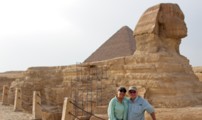We docked at the seaport of Muziris near the city of Cochin in the state of Kerala in the country of India. This port was key to trade between – well, just about everyone. The important commodities exported were spices, black pepper being the king of spice. Pepper has been found in Egyptian tombs; hence ancient mariners navigated to Kerela for its wild pepper at least 2,500 years prior to any European trade. The Portuguese explorer, Vasco de Gama was the first European to reach India by sea and setup the link between Europe and Asia by connecting the Atlantic and the Indian oceans.
Today, our excursion took us to India’s first Christian Church. It was founded by St. Thomas, one of Christs 12 apostles and named St Thomas Cathedral. We saw the Sacred Pond (which needed some Simple Green and a big scrub brush) where St Thomas baptized many of the Hindu’s into Christianity. The estimated date of these baptisms is 53 AD.
Then to the Paravur Synagogue Museum. Many Jewish communities came here and were involved in trade, again, centuries prior to the birth of Christ. They received special privileges from the king to build Synagogues. They were repeatedly attacked by the Portuguese and Dutch. When Israel came into being, many Jews returned and the Synagogues were left unattended and worship stopped. There are no Jews left; however, the Synagogue is maintained in case the Jews return to the area.
The Paliam Museum is next. It’s under renovation but we were guided inside for a look. It’s a very old family home, with 100’s of rooms, which were occupied by several generations of matriarchal family members. Over 100 women and minor boys lived here together and they followed an inheritance system through the mothers. Duties were shared by all who lived there. Occasionally, husbands could come into the house after 8pm to visit their wives and had to be out by 5am. (If it sounds weird, it was; but it worked for them). The highest ranking Noble woman made the decision as to who would live in the house.
Next up was the Paliam Palace which was of Dutch architecture and the official residence of the oldest male of the Paliam Noble family.
Our last stop was to a weaving factory where employees were working the looms. Monotonous and hot is all I can say. While waiting for us, our driver got us all some bananas right off the tree and passed them out with bottled water. I have to say India has some of the sweetest bananas I’ve ever eaten. Because of the thick skin and careful peeling, we were informed by our ships medical officers that bananas were likely safe to eat off the ship.
Kerala has virtually 100% literacy rate. The life expectancy for the region is 84 years. The ratio of adult males to females is 1,000 / 1,050. In some regions of India it is 1,000 / 700 because girls are aborted, are starved to death in early childhood, or have “accidents.” There are mountains about 100 miles to the east that are the source of 40 rivers that flow downhill to the west; Kerala has a source of clean and predictable water. Our guide was very proud of his region.
Our guide was very open about all things India. He told us he was in an arranged marriage and explained how the whole thing works. He says his marriage is healthy. He has 2 boys, age 1 ½ and 3. Wife is a nurse. He’s the youngest son so they live with his parents. That means his oldest son will get a piece of land and be able to move out but his youngest son will marry and bring his wife into family home. He was very philosophical. This was my take away from him “In life, you might not always get what you like, so like what you get” and “Why waste time being angry, you will never get that time back”.




















